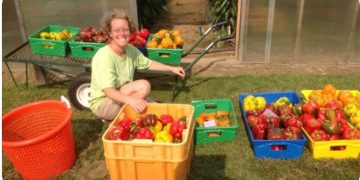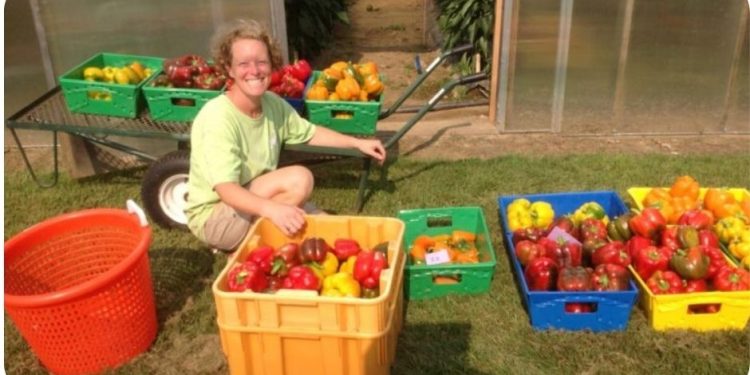New Hampshire farmers looking to grow colored bell peppers in high tunnels will be pleased to learn that researchers from the NH Agricultural Experiment Station found many varieties produced excellent, high-quality fruit in a research trial conducted at the experiment station’s Woodman Horticultural Research Farm.
Becky Sideman, a researcher with the NH Agricultural Experiment Station and extension professor of sustainable horticulture production, Kaitlyn Orde, graduate student in agricultural sciences, and Talia Levy, undergraduate student in sustainable agriculture and food systems, recently conducted a colored bell pepper trial to determine the most suitable varieties for production in New Hampshire in an unheated high-tunnel environment.
“Growing peppers in unheated high tunnels permits the production of very high quality colored fruit. Colored bell peppers have the potential to be a profitable, alternative crop for New Hampshire farmers, although a number of factors such as infrastructure costs, marketable yield, and market prices need to be considered,” Sideman said.
Researchers collected information on overall total yields and marketable yields of 10 varieties of colored bell peppers. The varieties UNH evaluated included Bentley, Felicitas, Orangela, Sympathy, Early Sunsation, Moonset, Karma, Sprinter, Karisma, and Orange Blaze.

Sideman and her team obtained yields ranging from 3.5 to 5 pounds of fruit per plant, with total yields ranging from 46,000 to 66,600 pounds per acre. This is more than double typical field pepper yields of 23,000 to 27,000 pounds per acre.
The highest yields were produced by Bentley, Felicitas, and Orangela, all classified as High-Tech Greenhouse Peppers by Johnny’s Select Seeds. For total weight of marketable fruit, Orange Blaze, a small-fruited type, produced significantly lower yields than both Bentley and Felicita. Otherwise, there were no significant differences.
Researchers found there was a direct relationship between fruit size and number of fruits produced per plant. Orange Blaze (average fruit size of 4.1 oz.) produced significantly more fruit per plant than all other varieties, whereas Karisma (average fruit size of 11.2 oz.) produced the fewest fruits per plant. Both peppers are field peppers by Harris Seeds. The number and percentage of unmarketable fruit was low for all varieties.
The researchers also found that the most common fruit defect was sunscald, which can be difficult to distinguish from blossom end rot in pepper. The other common defect was Alternaria fruit rot caused by the fungus Alternaria alternata.
“Successful pepper production in tunnels requires attention to various pests, and it may be possible to increase yields by earlier planting, alternative spacing and pruning systems, or other means,” Sideman said.
Researchers plan to continue their research on colored bell pepper varieties this summer.
This material is based upon work supported by the NH Agricultural Experiment Station, through joint funding of the National Institute of Food and Agriculture, U.S. Department of Agriculture, under award number 228522, and the state of New Hampshire. For additional information on this research, visit extension.unh.edu/resources/files/Resource005720_Rep8006.pdf.
— Lori Wright, University of New Hampshire
Source: NH Agricultural Experiment Station































